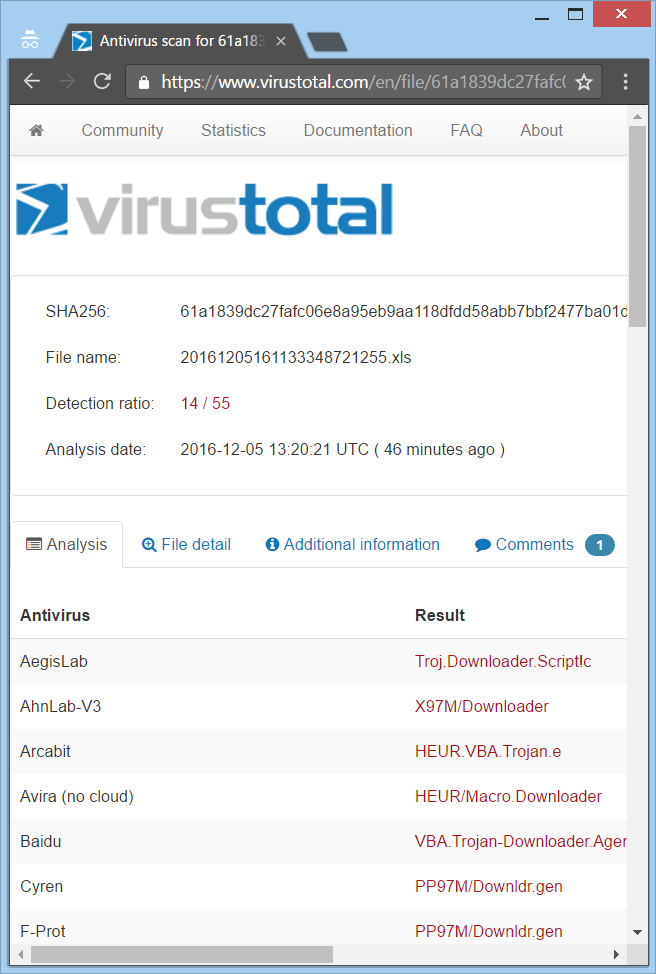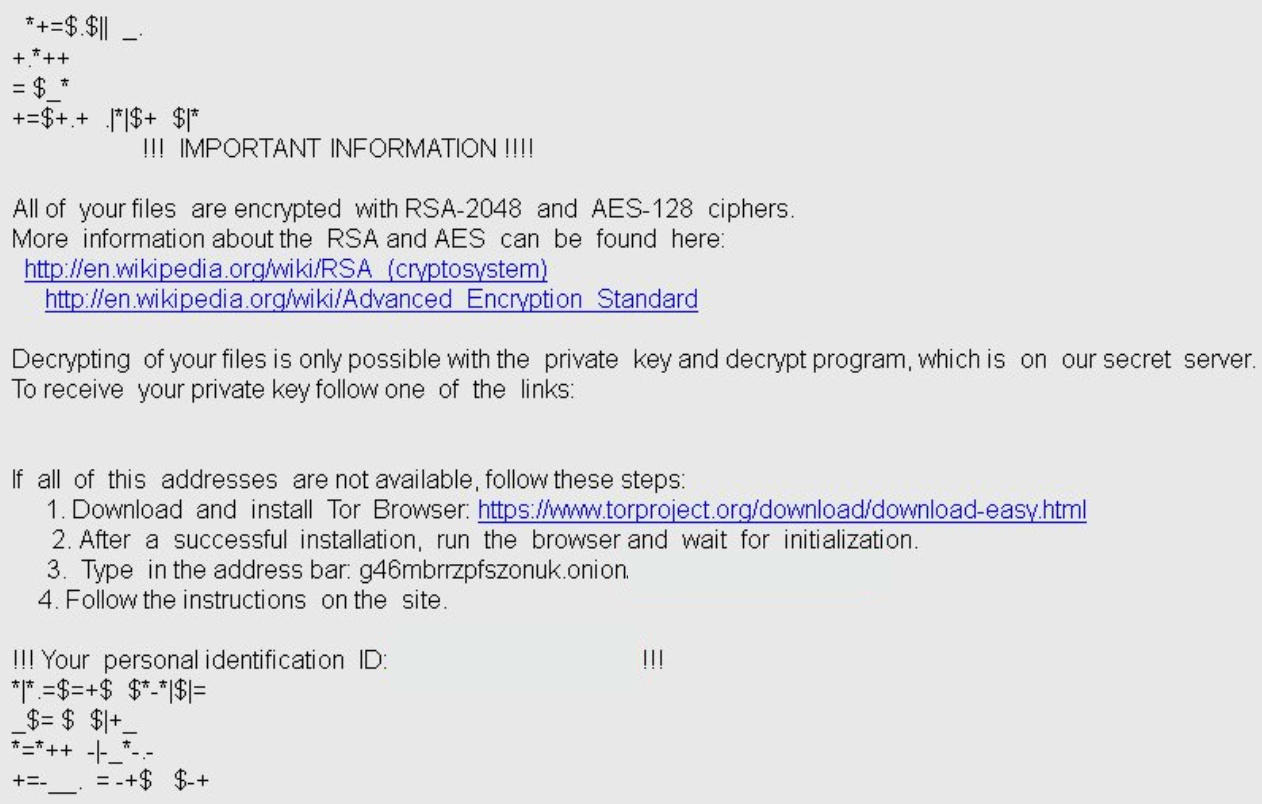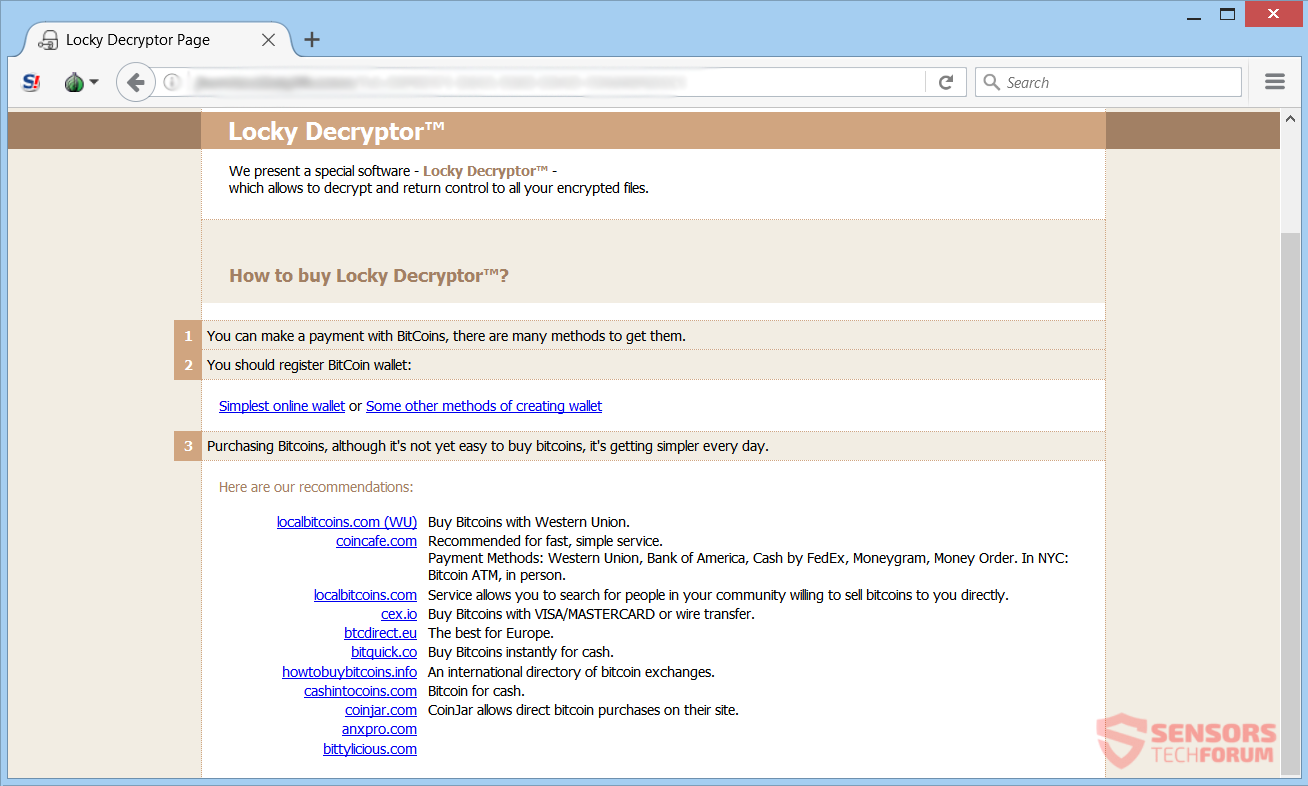Attention! This article will help you remove .osiris file extension virus (Locky ransomware) successfully. Follow the ransomware removal instructions below carefully.
Locky ransomware has hit computers once more. This time, your files will become encrypted with the extension .osiris and the name of the encrypted files will also get changed. The malware creators seem to have changed their Norse mythology theme with the Egyptian one. Furthermore, there are changes to the code of the cryptovirus in attempt to avoid detection. A new spam campaign is distributing the malware with blank emails or such with only one line in them. They have files attached with unusual extensions like .342, .343, .552 or with .xls, .tdb, .zk and some emails have one sentence urging users to open the attachment. To see if you can try to restore some of your files read till the end.

Threat Summary
| Name | .osiris Virus |
| Type | Ransomware, Cryptovirus |
| Short Description | The ransomware encrypts your data and then displays a ransom message with instructions for payment. |
| Symptoms | Encrypted files will have the .osiris extension appended to them. |
| Distribution Method | Spam Emails, Email Attachments (.xls, .tdb, .zk, .342, .343, .552) |
| Detection Tool |
See If Your System Has Been Affected by malware
Download
Malware Removal Tool
|
User Experience | Join Our Forum to Discuss .osiris Virus. |
| Data Recovery Tool | Windows Data Recovery by Stellar Phoenix Notice! This product scans your drive sectors to recover lost files and it may not recover 100% of the encrypted files, but only few of them, depending on the situation and whether or not you have reformatted your drive. |

.osiris Virus – Infection Spread
.osiris virus – the latest iteration of the Locky ransomware has been spread by a new malware spam campaign and two main types of emails. The malware creators are spreading their virus with a completely blank email or with one, which is urging users to see an attached file. Both types of emails are using an attachment with random numbers as its name with these extensions – .xls, .tdb, .zk, .342, .343, .552.
The body of the second type of email can be seen down here:
From: “Marina” Marina.jeffeaux91@klachurch.org
Subject: Emailing: _0828817_36073220Your message is ready to be sent with the following file or link
attachments:_0828817_36073220
Attachment: _0828817_36073220.xls
The attachment in most such electronic letters usually contains a Microsoft Word file containing a macro that will download the malware. Once executed, your computer becomes infected with .osiris virus. You can see two examples of payload downloaders for the newest version of the ransomware on the VirusTotal website:
.osiris virus can also be spread around social media sites such as Facebook. Refrain from interacting with any suspicious and unknown links, attachments and files as a general rule of thumb. Before opening a file, always perform a check with a security tool. You should read the ransomware preventing tips in our forum to learn how you can prevent these types of threats to infect your computer.

.osiris Virus – Technical Analysis
Malware researchers have reported .osiris virus to infect computers with a different version and to encrypt files with a new extension – .osiris. It seems that the Norse mythology theme has been converted to the Egyptian one. Some of the sites that download the payload file can be seen below:
Do not open any of these links, as they contain a malware downloader. This is posted for informing about download URLs of the malware.
You can also see some of the C2 (Command and Control) servers right here:
- POST https://91.142.90.61/checkupdate
- POST https://185.82.217.28/checkupdate
- POST https://195.19.192.99/checkupdate
When the payload is executed, your files will become encrypted, and a ransom note will be displayed on your desktop background. The note with the payment instructions will also be saved as a file named OSIRIS-([a-z0-9])\.htm, where the brackets contain symbols with randomized numbers and letters.
The ransom note with instructions is set as your desktop background, and it is almost the same as past iterations. You can see how it looks like if loaded as an .html file.
The text reads the following:
!!! IMPORTANT INFORMATION !!!
All of your files are encrypted with RSA-2048 and AES-128 ciphers.
More information about the RSA and AES can be found here:
https://en.wikipedia.org/wiki/RSA_(cryptosystem)
https://en.wikipedia.org/wiki/Advanced_Encryption_Standard
Decrypting of your files is only possible with the private key and decrypt program, All which is on our secret server.
To receive your private key follow one of the links:If all of this addresses are not available, follow these steps:
1. Download and install Tor Browser: https://www.torproject.org/download/download-easy.html
2. After a successful installation, run the browser and wait for initialization.
3. Type in the address bar: g46mbrrzpfszonuk.onion/[Redacted] 4. Follow the instructions on the site.
!!! Your personal identification ID: [Redacted] !!!
The .osiris virus will provide a link to a network domain hidden within the TOR browser service. The domain looks exactly like the one of its predecessors as you can see right here:
Some of the previous victims of Locky ransomware have reported that paying the ransom designated by the cybercriminals did not recover their files. Thus, you should not attempt contacting these crooks or paying them any money. Until this moment we only can conclude that the malware creators will continue developing new versions of the ransomware and extort people by encrypting their files.
For the moment, a list with the file types which become encrypted is not available. Files with the following extensions may get encrypted:
→.txt, .pdf, .html, .rtf, .avi, .mov, .mp3, .mp4, .dwg, .psd, .svg, .indd, .cpp, .pas, .php, .java, .jpg, .jpeg, .bmp, .tiff, .png, .doc, .docx, .xls, .xlsx, .ppt, .pptx
Encrypted files will have the .osiris extension appended to them, but also their names will be changed with randomized symbols of letters and numbers, just like the ransom note. The encryption algorithm that is still claimed to be used by Locky is RSA-2048 with AES 128-bit ciphers.
.osiris virus is very likely to delete the Shadow Volume Copies on the Windows operating system with the following command:
→vssadmin.exe delete shadows /all /Quiet
Continue to read and see how to remove this ransomware and and also – what methods you can try to decrypt some of your data.

Remove .osiris Virus and Restore .osiris Files
If your computer got infected with the .osiris virus, you should have some experience in removing malware. You should get rid of this ransomware as fast as possible before it can have the chance to spread further and infect more computers. You should remove the ransomware and follow the step-by-step instructions guide given below. To see ways that you can try to recover your data, see the step titled 2. Restore files encrypted by .osiris virus.
- Step 1
- Step 2
- Step 3
- Step 4
- Step 5
Step 1: Scan for .osiris Virus with SpyHunter Anti-Malware Tool



Ransomware Automatic Removal - Video Guide
Step 2: Uninstall .osiris Virus and related malware from Windows
Here is a method in few easy steps that should be able to uninstall most programs. No matter if you are using Windows 10, 8, 7, Vista or XP, those steps will get the job done. Dragging the program or its folder to the recycle bin can be a very bad decision. If you do that, bits and pieces of the program are left behind, and that can lead to unstable work of your PC, errors with the file type associations and other unpleasant activities. The proper way to get a program off your computer is to Uninstall it. To do that:


 Follow the instructions above and you will successfully delete most unwanted and malicious programs.
Follow the instructions above and you will successfully delete most unwanted and malicious programs.
Step 3: Clean any registries, created by .osiris Virus on your computer.
The usually targeted registries of Windows machines are the following:
- HKEY_LOCAL_MACHINE\Software\Microsoft\Windows\CurrentVersion\Run
- HKEY_CURRENT_USER\Software\Microsoft\Windows\CurrentVersion\Run
- HKEY_LOCAL_MACHINE\Software\Microsoft\Windows\CurrentVersion\RunOnce
- HKEY_CURRENT_USER\Software\Microsoft\Windows\CurrentVersion\RunOnce
You can access them by opening the Windows registry editor and deleting any values, created by .osiris Virus there. This can happen by following the steps underneath:


 Tip: To find a virus-created value, you can right-click on it and click "Modify" to see which file it is set to run. If this is the virus file location, remove the value.
Tip: To find a virus-created value, you can right-click on it and click "Modify" to see which file it is set to run. If this is the virus file location, remove the value.
Before starting "Step 4", please boot back into Normal mode, in case you are currently in Safe Mode.
This will enable you to install and use SpyHunter 5 successfully.
Step 4: Boot Your PC In Safe Mode to isolate and remove .osiris Virus





Step 5: Try to Restore Files Encrypted by .osiris Virus.
Method 1: Use STOP Decrypter by Emsisoft.
Not all variants of this ransomware can be decrypted for free, but we have added the decryptor used by researchers that is often updated with the variants which become eventually decrypted. You can try and decrypt your files using the instructions below, but if they do not work, then unfortunately your variant of the ransomware virus is not decryptable.
Follow the instructions below to use the Emsisoft decrypter and decrypt your files for free. You can download the Emsisoft decryption tool linked here and then follow the steps provided below:
1 Right-click on the decrypter and click on Run as Administrator as shown below:

2. Agree with the license terms:

3. Click on "Add Folder" and then add the folders where you want files decrypted as shown underneath:

4. Click on "Decrypt" and wait for your files to be decoded.

Note: Credit for the decryptor goes to Emsisoft researchers who have made the breakthrough with this virus.
Method 2: Use data recovery software
Ransomware infections and .osiris Virus aim to encrypt your files using an encryption algorithm which may be very difficult to decrypt. This is why we have suggested a data recovery method that may help you go around direct decryption and try to restore your files. Bear in mind that this method may not be 100% effective but may also help you a little or a lot in different situations.
Simply click on the link and on the website menus on the top, choose Data Recovery - Data Recovery Wizard for Windows or Mac (depending on your OS), and then download and run the tool.
.osiris Virus-FAQ
What is .osiris Virus Ransomware?
.osiris Virus is a ransomware infection - the malicious software that enters your computer silently and blocks either access to the computer itself or encrypt your files.
Many ransomware viruses use sophisticated encryption algorithms to make your files inaccessible. The goal of ransomware infections is to demand that you pay a ransom payment to get access to your files back.
What Does .osiris Virus Ransomware Do?
Ransomware in general is a malicious software that is designed to block access to your computer or files until a ransom is paid.
Ransomware viruses can also damage your system, corrupt data and delete files, resulting in the permanent loss of important files.
How Does .osiris Virus Infect?
Via several ways..osiris Virus Ransomware infects computers by being sent via phishing emails, containing virus attachment. This attachment is usually masked as an important document, like an invoice, bank document or even a plane ticket and it looks very convincing to users.
Another way you may become a victim of .osiris Virus is if you download a fake installer, crack or patch from a low reputation website or if you click on a virus link. Many users report getting a ransomware infection by downloading torrents.
How to Open ..osiris Virus files?
You can't without a decryptor. At this point, the ..osiris Virus files are encrypted. You can only open them once they are decrypted using a specific decryption key for the particular algorithm.
What to Do If a Decryptor Does Not Work?
Do not panic, and backup the files. If a decryptor did not decrypt your ..osiris Virus files successfully, then do not despair, because this virus is still new.
Can I Restore "..osiris Virus" Files?
Yes, sometimes files can be restored. We have suggested several file recovery methods that could work if you want to restore ..osiris Virus files.
These methods are in no way 100% guaranteed that you will be able to get your files back. But if you have a backup, your chances of success are much greater.
How To Get Rid of .osiris Virus Virus?
The safest way and the most efficient one for the removal of this ransomware infection is the use a professional anti-malware program.
It will scan for and locate .osiris Virus ransomware and then remove it without causing any additional harm to your important ..osiris Virus files.
Can I Report Ransomware to Authorities?
In case your computer got infected with a ransomware infection, you can report it to the local Police departments. It can help authorities worldwide track and determine the perpetrators behind the virus that has infected your computer.
Below, we have prepared a list with government websites, where you can file a report in case you are a victim of a cybercrime:
Cyber-security authorities, responsible for handling ransomware attack reports in different regions all over the world:
Germany - Offizielles Portal der deutschen Polizei
United States - IC3 Internet Crime Complaint Centre
United Kingdom - Action Fraud Police
France - Ministère de l'Intérieur
Italy - Polizia Di Stato
Spain - Policía Nacional
Netherlands - Politie
Poland - Policja
Portugal - Polícia Judiciária
Greece - Cyber Crime Unit (Hellenic Police)
India - Mumbai Police - CyberCrime Investigation Cell
Australia - Australian High Tech Crime Center
Reports may be responded to in different timeframes, depending on your local authorities.
Can You Stop Ransomware from Encrypting Your Files?
Yes, you can prevent ransomware. The best way to do this is to ensure your computer system is updated with the latest security patches, use a reputable anti-malware program and firewall, backup your important files frequently, and avoid clicking on malicious links or downloading unknown files.
Can .osiris Virus Ransomware Steal Your Data?
Yes, in most cases ransomware will steal your information. It is a form of malware that steals data from a user's computer, encrypts it, and then demands a ransom in order to decrypt it.
In many cases, the malware authors or attackers will threaten to delete the data or publish it online unless the ransom is paid.
Can Ransomware Infect WiFi?
Yes, ransomware can infect WiFi networks, as malicious actors can use it to gain control of the network, steal confidential data, and lock out users. If a ransomware attack is successful, it could lead to a loss of service and/or data, and in some cases, financial losses.
Should I Pay Ransomware?
No, you should not pay ransomware extortionists. Paying them only encourages criminals and does not guarantee that the files or data will be restored. The better approach is to have a secure backup of important data and be vigilant about security in the first place.
What Happens If I Don't Pay Ransom?
If you don't pay the ransom, the hackers may still have access to your computer, data, or files and may continue to threaten to expose or delete them, or even use them to commit cybercrimes. In some cases, they may even continue to demand additional ransom payments.
Can a Ransomware Attack Be Detected?
Yes, ransomware can be detected. Anti-malware software and other advanced security tools can detect ransomware and alert the user when it is present on a machine.
It is important to stay up-to-date on the latest security measures and to keep security software updated to ensure ransomware can be detected and prevented.
Do Ransomware Criminals Get Caught?
Yes, ransomware criminals do get caught. Law enforcement agencies, such as the FBI, Interpol and others have been successful in tracking down and prosecuting ransomware criminals in the US and other countries. As ransomware threats continue to increase, so does the enforcement activity.
About the .osiris Virus Research
The content we publish on SensorsTechForum.com, this .osiris Virus how-to removal guide included, is the outcome of extensive research, hard work and our team’s devotion to help you remove the specific malware and restore your encrypted files.
How did we conduct the research on this ransomware?
Our research is based on an independent investigation. We are in contact with independent security researchers, and as such, we receive daily updates on the latest malware and ransomware definitions.
Furthermore, the research behind the .osiris Virus ransomware threat is backed with VirusTotal and the NoMoreRansom project.
To better understand the ransomware threat, please refer to the following articles which provide knowledgeable details.
As a site that has been dedicated to providing free removal instructions for ransomware and malware since 2014, SensorsTechForum’s recommendation is to only pay attention to trustworthy sources.
How to recognize trustworthy sources:
- Always check "About Us" web page.
- Profile of the content creator.
- Make sure that real people are behind the site and not fake names and profiles.
- Verify Facebook, LinkedIn and Twitter personal profiles.






